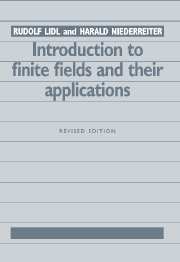

Niederreiter, Harald 1995. Monte Carlo and Quasi-Monte Carlo Methods in Scientific Computing. Vol. 106, Issue. , p. 87.
Meyn, Helmut 1995. ExplicitN-polynomials of 2-power degree over finite fields, I. Designs, Codes and Cryptography, Vol. 6, Issue. 2, p. 107.
Blackburn, S. R. 1996. A note on sequences with the shift and add property. Designs, Codes and Cryptography, Vol. 9, Issue. 3, p. 251.
Muzhong Wang and Blake, I.F. 1997. Normal basis of the finite field F/sub 2/(p-1)p/sup m/ over F/sub 2/. IEEE Transactions on Information Theory, Vol. 43, Issue. 2, p. 737.
Koc, C.K. and Acar, T. 1997. Fast software exponentiation in GF(2/sup k/). p. 225.Hofmeister, Thomas Krause, Matthias and Simon, Hans U. 1997. Computing and Combinatorics. Vol. 1276, Issue. , p. 176.
Roth, R.M. 1997. Probabilistic crisscross error correction. IEEE Transactions on Information Theory, Vol. 43, Issue. 5, p. 1425.
Bodlaender, Hans L. and Hagerup, Torben 1998. Parallel Algorithms with Optimal Speedup for Bounded Treewidth. SIAM Journal on Computing, Vol. 27, Issue. 6, p. 1725.
Rieke, A. Sadeghi, A.-R. and Poguntke, W. 1998. On primitivity tests for polynomials. p. 53.Ar, Sigal Lipton, Richard J. Rubinfeld, Ronitt and Sudan, Madhu 1998. Reconstructing Algebraic Functions from Mixed Data. SIAM Journal on Computing, Vol. 28, Issue. 2, p. 487.
Safavi-Naini, Rei Bakhtiari, Shahram and Charnes, Chris 1998. Fast Software Encryption. Vol. 1372, Issue. , p. 134.
Niederreiter, Harald and Xing, Chaoping 1998. Towers of Global Function Fields with Asymptotically Many Rational Places and an Improvement on the Gilbert ‐ Varshamov Bound. Mathematische Nachrichten, Vol. 195, Issue. 1, p. 171.
Mitchell, Chris J. and Paterson, Kenneth G. 1998. Perfect Factors from Cyclic Codes and Interleaving. SIAM Journal on Discrete Mathematics, Vol. 11, Issue. 2, p. 241.
Murphy, S. 1998. Comment: Bound for linear complexity of BBS sequences. Electronics Letters, Vol. 34, Issue. 11, p. 1057.
Espona, M. and Serra, O. 1998. Cayley Digraphs Based on the de Bruijn Networks. SIAM Journal on Discrete Mathematics, Vol. 11, Issue. 2, p. 305.
Koc, C.K. and Sunar, B. 1998. Low-complexity bit-parallel canonical and normal basis multipliers for a class of finite fields. IEEE Transactions on Computers, Vol. 47, Issue. 3, p. 353.
Halbutoğullari, A. and Koç, Ç. K. 1999. Applied Algebra, Algebraic Algorithms and Error-Correcting Codes. Vol. 1719, Issue. , p. 498.
Maurer, Ueli M. and Wolf, Stefan 1999. The Relationship Between Breaking the Diffie--Hellman Protocol and Computing Discrete Logarithms. SIAM Journal on Computing, Vol. 28, Issue. 5, p. 1689.
Rosenthal, J. and York, F.V. 1999. BCH convolutional codes. IEEE Transactions on Information Theory, Vol. 45, Issue. 6, p. 1833.
Jin Young Oo Young-Gern Kim Dong-Young Park and Heung-Su Kim 1999. Efficient multiplier architecture using optimized irreducible polynomial over GF((3/sup n/)/sup 3/). Vol. 1, Issue. , p. 383.
The theory of finite fields is a branch of modern algebra that has come to the fore in recent years because of its diverse applications in such areas as combinatorics, coding theory, cryptology and the mathematical study of switching circuits. The first part of this updated edition presents an introduction to this theory, emphasising those aspects that are relevant for application. The second part is devoted to a discussion of the most important applications of finite fields, especially to information theory, algebraic coding theory and cryptology. There is also a chapter on applications within mathematics, such as finite geometries, combinatorics and pseudo-random sequences. The book is meant to be used as a textbook: worked examples and copious exercises that range from the routine, to those giving alternative proofs of key theorems, to extensions of material covered in the text, are provided throughout. It will appeal to advanced undergraduates and graduate students taking courses on topics in algebra, whether they have backgrounds in mathematics, electrical engineering or computer science. Non-specialists will also find this a readily accessible introduction to an active and increasingly important subject.
‘ … a model of how a text book should be written; it is clear, unfussy and contains lots of examples … of particular interest to anybody wishing to teach a course in concrete algebra‘
‘ … a very useful and highly readable introduction to the classical theory and the standard applications of finite fields. It has a clear and precise presentation with many examples and a large selection of exercises.’
Source: The Mathematical Gazette